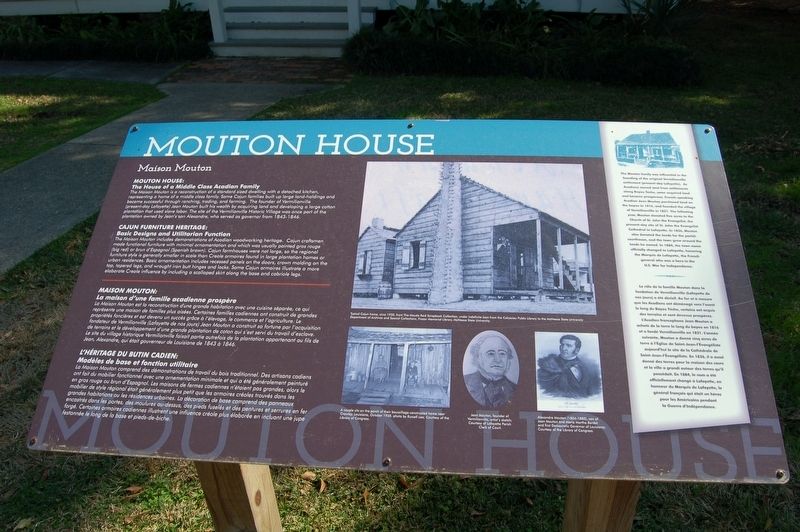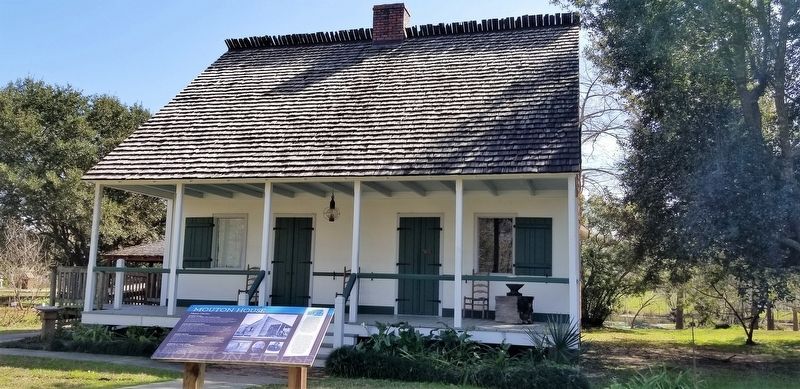Mouton House
Maison Mouton
Mouton House:
The House of a Middle Class Acadian Family
The Maison Mouton is a reconstruction of a standard sized dwelling with a detached kitchen, representing a home of a middle class family. Some Cajun families built up large land-holdings and became successful through ranching, trading, and farming. The founder of Vermilionville (present-day Lafayette) Jean Mouton built his wealth by acquiring land and developing a large cotton plantation that used slave labor. The site of the Vermilionville Historic Village was once part of the plantation owned by Jean's son Alexandre, who served as governor from 1843-1846.
CAJUN FURNITURE HERITAGE:
Basic Designs and Utilitarian Function
The Maison Mouton includes demonstrations of Acadian woodworking heritage. Cajun craftsmen made functional furniture with minimal ornamentation and which was usually painted gros rouge (big red) or brun d'Espagnol (Spanish brown). Cajun farmhouses were not large, so the regional furniture style is generally smaller in scale than Creole armoires found in large plantation homes or urban residences. Basic ornamentation includes recessed panels on the doors, crown molding on the top, tapered legs, and wrought iron butt hinges and locks. Some Cajun armoires illustrate a more elaborate Creole influence
-------------------------------------------------------------------------------------
MAISON MOUTON:
La maison d'une famille acadienne prospère
La Maison Mouton est la reconstruction d'une grande habitation avec une cuisine séparée, ce qui représente une maison de families plus aisées. Certaines families cadiennes ont construit de grandes proprietes foncières et est devenu un succès grâce, à l'élevage, le commerce et l'agriculture. Le fondateur de Vermilionville (Lafayette de nos fours) Jean Mouton a construit sa fortune par l'acquisition de terrains et le développement d'une grande plantation de coton qui s'est servi du travail d'esclave. Le site du village historique Vermilionville faisait partie autrefois de la plantation appartenant au fits de Jean, Alexandre, qui etait gouverneur de Louisiane de 1843 à 1846.
L'HÉRITAGE DU BUTIN CADIEN:
Modèles de base et fonction utilitaire
La Maison Mouton comprend des démonstrations de travail du bois traditionnel. Des artisans cadiens ont fait du mobilier fonctionnel avec une ornementation minimale et qui a été généralement peinturé en gros rouge ou brun d'Espagnol. Les maisons de fermes cadiennes n'étaient pas grandes, alors le mobilier de style régional était généralement plus petit que les armoires
The Mouton family was influential in the founding of the original Vermilionville settlement (present-day Lafayette). As Acadians moved west from settlements along Bayou Teche, some acquired land and became prosperous. French-speaking Acadian Jean Mouton purchased land on the bayou in 1816, and founded the village of Vermilionville in 1821. The following year, Mouton donated five acres to the Church of St. John the Evangelist, the present-day site of St. John the Evangelist Cathedral in Lafayette. In 1836, Mouton also donated the lands for the parish courthouse, and the town grew around the lands he owned. In 1884, the town name officially changed to Lafayette, honoring the Marquis de Lafayette, the French general who was a hero in the U.S. War for Independence.
---------------------------------------------------------------------------------------
Le rôle de la famille Mouton dans la fondation de Vermilionville (Lafayette de nos jours) a été décisif. Au fur et à mesure que les Acadiens ont déménagé vers l'ouest le long du Bayou Téche, certains ont acquis des terrains et sont devenus prospéres. L'Acadien francophone Jean Mouton a acheté de la terre le long du bayou en 1816 et a fondé Vermilionville en 1821. L'année suivante, Mouton a donné cinq acres de terre à l'Église de Saint-Jean-l'Évangéliste aujourd'hui le site de la Cathédrale de Saint-Jean-l'Élivangeliste. En 1836, it a aussi donné des terres pour la maison des tours et la ville a grandi autour des terres qu'il possédait. En 1884, le nom a été officiellement changé à Lafayette, en honneur du Marquis de Lafayette, le général français qui était un héros pour les Américains pendant la Guerre d'Indépendance.
Topics. This historical marker is listed in this topic list: Settlements & Settlers.
Location. 30° 12.93′ N, 91° 59.687′ W. Marker is in Lafayette, Louisiana, in Lafayette Parish. Marker can be reached from Fisher Road near Surrey Street (State Road 728-8), on the right when traveling west. Touch for map. Marker is at or near this postal address: 300 Fisher Road, Lafayette LA 70508, United States of America. Touch for directions.
Other nearby markers. At least 8 other markers are within walking distance of this marker. Mouton Kitchen (a few steps from this marker); School House (a few steps from this marker); Acadian House (within shouting distance of this marker); The Forge (within shouting distance of this marker); Beau Bassin House (within shouting distance of this marker); Buller House (within shouting distance of this marker); Boucvalt House (within shouting distance of this marker); The Presbytery (within shouting distance of this marker). Touch for a list and map of all markers in Lafayette.
More about this marker. Located on the grounds of the Vermilionville Heritage Museum, Admission required.
Also see . . . Vermilionville. Museum website homepage (Submitted on June 7, 2019, by Cajun Scrambler of Assumption, Louisiana.)
Credits. This page was last revised on December 18, 2022. It was originally submitted on June 7, 2019, by Cajun Scrambler of Assumption, Louisiana. This page has been viewed 798 times since then and 176 times this year. Photos: 1, 2. submitted on June 7, 2019.

